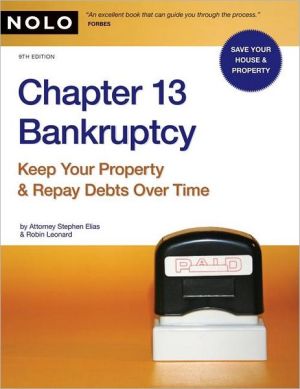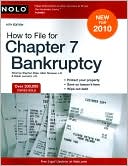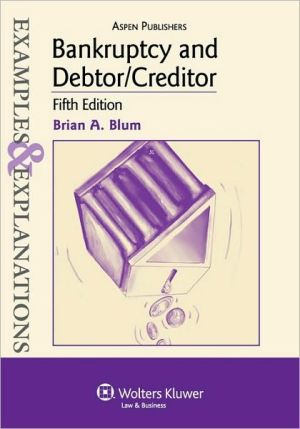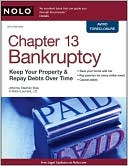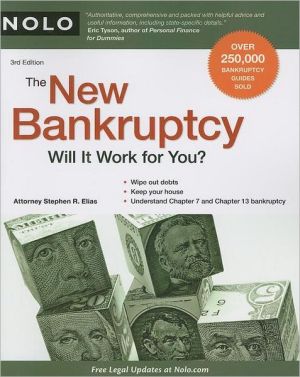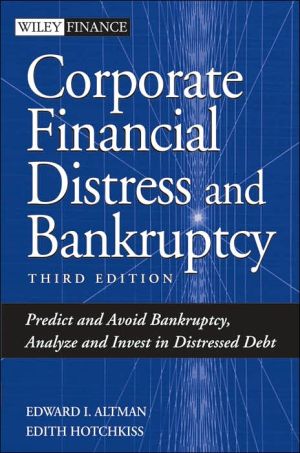Chapter 13 Bankruptcy: Keep Your Property & Repay Debts Over Time
Reduce your debts, save your property -- and start over! \ \ Are you behind on your mortgage, taxes or other bills? Are creditors threatening foreclosure or repossession? Consider Chapter 13 bankruptcy, which can provide you an affordable repayment plan -- and let you keep your house, car and other property. \ \ You can even avoid attorney fees and do it yourself -- let Chapter 13 Bankruptcy show the way. Find out how to: \ \ \ determine if you qualify for Chapter 13\ \ estimate monthly...
Search in google:
Reduce your debts, save your property -- and start over!Are you behind on your mortgage, taxes or other bills? Are creditors threatening foreclosure or repossession? This book will show you how to save your house, car and other assets with Chapter 13 Bankruptcy. It lets you cancel your debts and pay off the rest with an affordable repayment plan. And now you can avoid attorney fees and do it yourself -- let Chapter 13 Bankruptcy show you how to:determine if you qualify for Chapter 13 stop a house foreclosure estimate monthly payments devise an acceptable repayment plan complete and file forms make up missed mortgage payments pay off other debts represent yourself before a bankruptcy judge or trustee staff attorney, National Consumer Law Center and co-author, Consumer Bankruptcy Law and Practice - Gary Klein This is the best book going if you choose to file alone or if you want background on the Chapter 13 process.
Introduction \ Chances are good that you've picked up this book because your debts have become overwhelming. Maybe you are facing foreclosure on your home, repossession of your car, or constant letters and phone calls from debt collectors. Or perhaps, you've realized that your debts have grown far beyond your ability to repay them, and you're wondering if there's anything you can do to get back in control of your finances.\ Chapter 13 bankruptcy could be the best way to resolve your debt problems. When you file for Chapter 13, you agree to repay all or a portion of your debts over time, under the supervision of the bankruptcy court. Chapter 13 allows you to keep your property while using your income to repay some or all of your debts. In contrast, Chapter 7 bankruptcy allows you to immediately wipe out many debts, but in exchange, you must give up any property you own that isn't protected by state or federal exemption laws. (You'll find more information on Chapter 7, including how to decide whether Chapter 7 or Chapter 13 bankruptcy is the better remedy for your debt problems, in "Is Chapter 13 Right For You?" below.)\ This book explains every step in the Chapter 13 process, including who can use Chapter 13, how to file the necessary papers, and how to come up with a workable repayment plan. To help you get started, this Chapter provides an overview of Chapter 13 bankruptcy -- how it works and what it will do for you. It also explains other types of bankruptcy relief and options for dealing with your debts outside of bankruptcy.\ An Overview of Chapter 13 Bankruptcy \ Chapter 13 can be a good solution for people who need time to pay off certain debts and who have enough income to meet the Chapter 13 requirements. In Chapter 13, you get to keep all of your property, regardless of its value. However, you will have to pay your unsecured debtors (those to whom you owe credit card debts, medical debts, and most court judgments, for example) the value of the property you would lose if you filed for Chapter 7 bankruptcy.\ Here is a brief overview of the Chapter 13 bankruptcy process, from start to finish.\ Costs \ Everyone who files for Chapter 13 bankruptcy has to pay the filing fee of $274, due either when you file your initial bankruptcy paperwork or in four equal installments (with the court's permission). You'll also have to pay a fee -- typically about $100 total -- to the credit counseling agency where you receive your mandatory prefiling credit counseling and postfiling budget counseling. If you decide to hire a lawyer to help you with your case, you can expect to pay an additional $2,500 or more. You won't have to come up with the entire lawyer's fee all at once, but you will probably have to make a sizable initial payment (maybe $750-$1,000) and pay the rest off over the course of your plan.\ If you decide to handle your own case (as many do), you most likely will need to buy some information. This will typically consist of one or more of the following:\ \ one or more self-help law books on Chapter 13 bankruptcy, including this one (roughly $30-$50 a pop)\ telephonic legal advice from a lawyer (roughly $100-$200 an hour), and\ clerical assistance (help completing your forms) from a bankruptcy petition preparer (roughly $150-$250).\ \ Filing Your Papers \ To begin a Chapter 13 bankruptcy, you fill out a packet of forms in which you disclose your property, debts, and economic transactions during the several years before you file. If you are familiar with Chapter 7 bankruptcy, the official forms for Chapter 13 are pretty much the same.\ In addition, you must prepare or produce:\ \ A form (Form B22C: Statement of Current Monthly Income and Disposable Income Calculation for Use in Chapter 13) that determines whether your income is more or less than the median income in your state. This calculation determines how long your repayment plan must last. If your income is more than the median, your plan must last five years; if your income is less, you can propose a three-year plan. If your income is more than the median, you must also use this form to calculate how much disposable income you will have available to commit to your plan over the five-year period.\ Your Chapter 13 repayment plan, showing how you propose to pay your mandatory debts (child support, tax arrearages, and so on) and your other debts over the three- to five-year period. (See Ch. 8 for help creating a repayment plan that the court will approve.)\ A certificate showing you have participated in a credit counseling program during the 180-day period before filing for bankruptcy (this requirement is explained in Ch. 9). If the credit counseling agency comes up with a proposed repayment plan that would allow you to pay your debts outside of bankruptcy, you must submit this as well.\ Pay stubs received from your employer during the 60-day period before you file, along with an accompanying court form.\ Proof that you've filed your federal and state income tax returns for the previous four years.\ A copy of your most recent IRS income tax return (or a transcript of that return).\ \ Chs. 7 through 9 take you through the form preparation and filing process, step by step.\ The Repayment Plan \ When you file for Chapter 13, you must submit a repayment plan. This plan must demonstrate that you can pay your mandatory debts, and perhaps repay all or a portion of your other debts, over the three- or five-year repayment period.\ Which Debts Must Be Repaid\ Chapter 13 requires you to pay some of your debts in full -- and as much of your remaining debts as you can -- from the income you have available. Generally, you will have to be able to show, at the beginning of your case, that you are likely to have enough income to remain current on debts that secure collateral you want to keep (for example, a mortgage or car note) while paying off your back taxes, back child support owed to a child or ex-spouse, and any mortgage and secured debt arrearages you owe. And, as explained in Ch. 3, your plan also has to allow for total payments to your unsecured creditors that are at least equal to the value of your nonexempt property -- the property you would lose in a Chapter 7 bankruptcy.\ Of course, if you are willing to sell your home or give back your car, you can minimize the amount of debt you have to repay -- and you don't have to pay back all of the back child support you owe during your Chapter 13 repayment period if the support is owed to a government agency rather than your ex-spouse or child.\ EXAMPLE: Ken owes $27,000 in back child support. His ex-wife assigned this debt to the local government agency that enforces child support orders when she went on public assistance. Ken doesn't earn much income, and he would not be able to propose a confirmable Chapter 13 plan if he had to pay back the entire child support debt. Because he now owes the debt to a government agency rather than to his ex, however, he doesn't have to repay it all over the life of his plan. The remainder of the debt won't be discharged when his Chapter 13 case is over; he will continue to owe whatever he can't pay back after his bankruptcy case ends.\ Consider a "cramdown" to reduce your secured debts. In some instances, Chapter 13 allows you to reduce certain secured debts to the value of the collateral. For instance, if you owe $20,000 on a car that is worth only $15,000, you can reduce the debt to $15,000 and pay off that amount in equal installments over the life of the plan. This remedy -- called a cramdown -- makes it easier in some cases to keep collateral and still propose a confirmable plan. For more information on cramdowns, see Ch. 8.\ Length of the Repayment Period\ You must propose a repayment plan that lasts for either three or five years, depending on your income. as you'll learn in Ch. 4, the bankruptcy law now imposes a number of requirements on filers whose average monthly income in the six months before they file for bankruptcy is more than the median income in their state. Among other things, these filers must propose a five-year repayment plan.\ Filers whose average monthly income for the six-month period is less than the median have the choice of filing for either Chapter 7 or Chapter 13 bankruptcy (as long as they meet the other eligibility requirements and they don't have enough excess actual income to fund a Chapter 13 plan). If they use Chapter 13, these filers may propose a three-year repayment plan, and may use their actual expenses to calculate how much disposable income they will have to devote to that plan.\ Filers whose income is more than the median must propose a five-year repayment plan, and must use standard amounts set by the IRS -- rather than their actual expenses -- to calculate their disposable income. As a result, higher-income filers may have to devote more of their money, for a longer period of time, to repaying their debts.\ To learn more about how to calculate your average monthly income, find out whether you are above or below your state's median, and figure out which expenses to use in calculating your disposable income, see Ch. 4.\ Coming Up With a Plan the Judge Will Approve\ You can't proceed with a Chapter 13 bankruptcy unless a bankruptcy judge approves (confirms) your plan. As mentioned, some creditors are entitled to receive 100% of what you owe them, while others may receive a much smaller percentage or even nothing at all if you won't have any disposable income left over after the mandatory debts are paid. For example, a Chapter 13 plan must propose that any child support you owe to a spouse or child (as opposed to a government agency) will be paid in full over the life of your plan; otherwise, the judge will not confirm it. On the other hand, the judge can confirm a plan that doesn't repay any portion of your credit card debts if you won't have any disposable income left after paying your child support obligations, whether you owe them to your former spouse or to the government.\ You might have more -- or less -- "disposable income" than you think. To most of us, the term "disposable income" means the amount of income we have left over after paying our expenses. But the new bankruptcy law defines this term differently. Because the new law calculates your monthly income as the average you earned over the six months before filing for bankruptcy, and in some cases calculates your monthly expenses according to IRS standards (not what you actually spend for necessary items), you might find that the actual amount left in your bank account is more or less than your disposable income, as defined by law. For more information on calculating your disposable income, see Ch. 5.\ The Automatic Stay \ When you file for Chapter 13 bankruptcy, the bankruptcy court automatically issues an order preventing most creditors (with some exceptions) from taking action to collect a debt against you or your property. (However, the automatic stay doesn't apply if you've had two previous bankruptcy cases dismissed in the past year.) So, for example, if a foreclosure sale of your home or a vehicle repossession is in the works, the stay stops the sale or repossession dead in its tracks. The automatic stay is discussed in more detail in Ch. 2.\ The Meeting of Creditors \ Once you file your papers, the court will schedule a meeting of creditors within 20 to 40 days after your filing date -- and send notice of this meeting to you and the creditors listed in your bankruptcy papers. You (and your spouse if you have filed jointly) are required to attend. You'll need to bring two forms of identification -- a picture ID and proof of your Social Security number.\ A typical creditors' meeting lasts less than 15 minutes. The trustee will briefly go over any questions raised by the information you entered in the forms. As mentioned, no judge will be present. The trustee is likely to be most interested in the fairness and legality of your proposed repayment plan, and your ability to make the payments you have proposed. (See Ch. 8 for more on Chapter 13 plans.) The trustee has a vested interest in helping you successfully navigate the Chapter 13 process because the trustee gets paid a percentage of all payments doled out under your plan.\ The trustee will also make sure you have filed your tax returns for the previous four years. If not, the trustee will continue the creditors' meeting to give you a chance to file these returns. Ultimately, you will not be allowed to proceed with a Chapter 13 bankruptcy unless and until you bring your tax filings up to date.\ When the trustee is finished asking questions, any creditors who show up will have a chance to question you. Secured creditors will likely attend, especially if they have any objections to the plan you have proposed as part of your Chapter 13 filing. They may claim, for example, that your plan isn't feasible, that you're giving yourself too much time to pay your arrears on your car note or mortgage (if any), or that your plan proposes to pay less on a secured debt than the replacement value of the collateral.\ An unsecured creditor who is scheduled to receive very little under your plan might show up, too, if that creditor thinks you should cut your living expenses and thereby increase your disposable income (the amount from which unsecured creditors are paid). This is more likely to happen if you are using your actual expenses to compute your disposable income (as filers whose income is less than the state median are allowed to do) instead of standard expense figures set by the IRS.\ Come to the meeting prepared to negotiate with disgruntled creditors. If you agree to make changes to accommodate their objections, you must submit a modified plan. While the trustee won't use the creditors' meeting to rule on any objections raised by the creditors, the trustee may raise these objections on behalf of the creditors later, at your confirmation hearing before the judge.\ The Confirmation Hearing \ Chapter 13 bankruptcy requires at least one appearance before a bankruptcy judge. At this "confirmation hearing," which will be held shortly after the creditors' meeting, the judge either confirms (approves of) your proposed plan or sends you back to the drawing board for various reasons -- usually because your plan doesn't meet Chapter 13 requirements. (For example, a judge might reject your plan because you don't have enough income to pay off your priority creditors and stay current on your secured debts, such as a car note or mortgage.) You are entitled to amend your proposed plan until you get it right or the judge decides that it's hopeless. Each amendment requires a new confirmation hearing and appropriate written notice to your creditors. (For more information on the confirmation hearing and how to amend your plan and serve your creditors, see Ch. 10.) Once your plan is confirmed, it will govern your payments for the three- to five-year repayment period.
Part I 1. How Chapter 13 Works An Overview of Chapter 13 Bankruptcy Which Debts Are Discharged in Chapter 13 Bankruptcy Is Chapter 13 Right for You? Alternatives to Bankruptcy 2. The Automatic Stay How Long the Stay Lasts How the Stay Affects Common Collection Actions How the Stay Affects Actions Against Codebtors When the Stay Doesn't Apply Evictions 3. Are You Eligible to Use Chapter 13? Prior Bankruptcy Discharges May Postpone Your Chapter 13 Discharge Business Entities Can't File for Chapter 13 Bankruptcy Your Debts Must Not Be Too High You Must Be Current on Your Income Tax Filings You Must Keep Making Your Child Support and Alimony Payments You Must File Annual Income and Expense Reports Your Proposed Repayment Plan Must Pay All Required Debts Your Proposed Payments Must Equal the Value of Your Nonexempt Assets You Must Participate in an Approved Personal Financial Management Course 4. Do You Have to Use Chapter 13? Can You Pass the Means Test? Forced Conversion to Chapter 13 5. Can You Propose a Plan the Judge Will Approve? If Your Current Monthly Income Is Less Than Your State's Median Income If Your Current Monthly Income Is More Than Your State's Median Income Understanding Property Exemptions 6. Making the Decision Part II 7. Complete Your Bankruptcy Forms Get Some Information From the Court Required Forms For Married Filers Form 1 -- Voluntary Petition Form 6 -- Schedules Form 7 -- Statement of Financial Affairs Form 21 -- Statement of Social Security Number Form B22C -- Statement of Current Monthly Income and Means-Test Calculation Form B201 -- Notice to Individual Consumer Debtor Under § 342(b) of the Bankruptcy Code Mailing Matrix Income Deduction Order 8. Drafting Your Plan Chapter 13 Plan Formats What Your Plan Must Pay -- And to Whom Repayment of Unsecured Debts: Allowed Claims A Model Plan Format Sample Plan 9. Filing Your Bankruptcy Papers Gather the Necessary Documents Get Filing Information From the Court How to File Your Papers After You File 10. Handling Routine Matters After You File The Automatic Stay Dealing With the Trustee Make Your First Payment Keep Your Business Going The Meeting of Creditors Modifying Your Plan Before the Confirmation Hearing The Confirmation Hearing Modifying Your Plan After the Confirmation Hearing Amending Your Bankruptcy Forms Filing a Change of Address Filing Tax Returns Filing Annual Income and Expense Statements Personal Financial Management Counseling Part III 11. Handling Legal Issues Filing Motions Dealing With Creditors' Motions If an Unsecured Creditor Objects to Your Plan Handling Creditors' Claims Asking the Court to Eliminate Liens 12. Carrying Out Your Plan Making Plan Payments Selling Property Modifying Your Plan When Problems Come Up Attempts to Revoke Your Confirmation When You Complete Your Plan 13. If You Cannot Complete Your Plan Dismiss Your Case Convert Your Case to Chapter 7 Bankruptcy Seek a Hardship Discharge 14. Life After Bankruptcy Rebuilding Your Credit Attempts to Collect Clearly Discharged Debts Postbankruptcy Discrimination Attempts to Revoke Your Discharge 15. Help Beyond the Book Debt Relief Agencies Bankruptcy Petition Preparers Bankruptcy Lawyers Legal Research Glossary Appendixes 1. State and Federal Exemption Charts 2. Tear-Out Forms 3. Charts Index
\ Reference & Research Book NewsContains many tear-out forms, federal and state exemptions charts, and the most recent legal documents and instructions on how to fill them out.\ \ \ \ \ Forbes MagazineAn excellent book that can guide you through the [Chapter 13] process.\ \ \ Orange County RegisterIn Nolo's usual thorough fashion, here is a guide to an alternative to the typical Chapter 7 Bankruptcy.\ \ \ \ \ Consumers DigestAn excellent resource...\ \ \ \ \ The Midwest Book ReviewChapter 13 Bankruptcy will save you a fortune in attorney fees and confusion.\ \ \ \ \ Gary KleinThis is the best book going if you choose to file alone or if you want background on the Chapter 13 process.\ —staff attorney, National Consumer Law Center and co-author, Consumer Bankruptcy Law and Practice\ \ \ \ \ Forbes MagazineAn excellent book that can guide you through the [Chapter 13] process.\ \ \ \ \ Orange County RegisterIn Nolo’s usual thorough fashion, here is a guide to an alternative to the typical Chapter 7 Bankruptcy.\ \ \ \ \ Forbes MagazineAn excellent book that can guide you through the [Chapter 13] process.\ \ \ \ \ Forbes MagazineAn excellent book that can guide you through the [Chapter 13] process.\ \ \ \ \ Consumers DigestAn excellent resource...\ \ \ \ \ Orange County RegisterIn Nolo’s usual thorough fashion, here is a guide to an alternative to the typical Chapter 7 Bankruptcy.\ \ \ \ \ Consumers DigestAn excellent resource...\ \ \ \ \ San Francisco Chronicle"In Nolo's usual thorough fashion, here is a guide to an alternative to the typical Chapter 7 bankruptcy."\ \ \ \ \ From the Publisher" An excellent book that can guide you through the [Chapter 13] process. " Forbes Magazine"Chapter 13 Bankruptcy will save you a fortune in attorney fees and confusion." The Midwest Book Review\ \
